Consumer Protection Issues in Medicare + Choice – Report
Consumer Protection Issues in Medicare + Choice
This Report is available in PDF format.Return to top
Consumer Protection Issues in Medicare + Choice
The independent source for health policy research, polling, and news.
Consumer Protection Issues in Medicare + Choice
This Report is available in PDF format.Return to top
Consumer Protection Issues in Medicare + Choice
World AIDS Day 1998: An Update On Youth And HIV
New Survey Data On Teens
In November 1998, the Kaiser Family Foundation conducted a survey of 517 teens between the ages of 12 and 17.* The results…
What Teens say about HIV/AIDS:
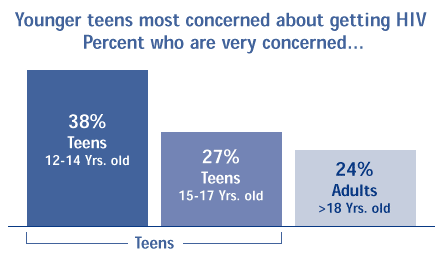
Where Teens Get Information about HIV/AIDS:
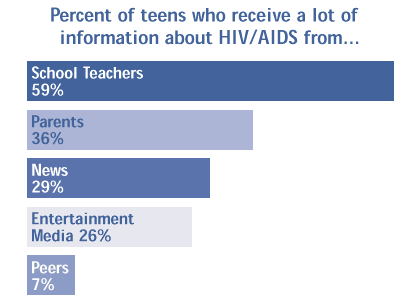
HIV and Youth: The Facts
What are young people doing that puts them at risk for HIV?
They are sexually active… A recent nationwide study of high school students found that:8
But, young people ARE protecting themselves and engaging in less sexually risky behavior:9
Why do young people put themselves at risk for HIV?
Young people’s assessment of risk and risk taking is based on a complex web of assumptions, perceived knowledge, and social dynamics. Key factors which influence unsafe sex behavior include:10
What young people are doing about HIV
Young people are involved in many HIV/AIDS related activities in their communities, schools, and families, including:
Footnotes:
1. Youth & HIV/AIDS: An American Agenda. A report to the President prepared by the Office of National AIDS Policy, March 1996.
2. Centers for Disease Control and Prevention, CDC Facts: Adolescents and HIV/AIDS, March 1998.
3. http://hivinsite.ucsf.edu, Kirby, Douglas, The AIDS Knowledge Base: HIV Prevention Among Adolescents, November 1997.
4. Centers for Disease Control and Prevention, CDC Facts: Adolescents and HIV/AIDS, March 1998; Centers for Disease Control and Prevention, HIV/AIDS Surveillance Report, 1997 Year-end edition, Vol. 9, No.2.
5. Rosenberg, S. and R. Biggar, “Trends in HIV Incidence Among Young Adults in the United States”, Journal of the American Medical Association, Vol. 279, pp. 1894-1899, June 1998.
6. Centers for Disease Control and Prevention, “Diagnosis and Reporting of HIV and AIDS in States with Integrated HIV and AIDS Surveillance – United States, January 1994-June 1997”, Morbidity and Mortality Weekly Report, Vol. 47, No. 15, April 1998.
7. Centers for Disease Control and Prevention, HIV/AIDS Surveillance Report, 1997 Year-end edition, Vol. 9, No.2.
8. Centers for Disease Control and Prevention, “Youth Risk Behavior Surveillance – United States, 1997”, Morbidity and Mortality Weekly Report, Surveillance Summary, Vol. 47, No.SS-3, August 1998.
9. Centers for Disease Control and Prevention, “Youth Risk Behavior Surveillance – United States, 1997”, Morbidity and Mortality Weekly Report, Surveillance Summary, Vol. 47, No.SS-3, August 1998; Centers for Disease Control and Prevention, “Trends in Sexual Risk Behaviors Among High School Students – United States, 1991-1997”, Morbidity and Mortality Weekly Report, Vol. 47, No. 36, September 1998.
10. Michaels Opinion Research, Center for AIDS Prevention Studies, and the Harvard AIDS Institute, Listen to What America’s Kids Are Saying: A Qualitative Research Study.
* This nationally representative telephone survey has a margin of error of +/- 4 percentage points.
Additional Resources:
For, It’s Your (Sex) Life, a free guide on safer sex, call 1-888-BE SAFE1 For, Talking With Kids About Tough Issues, a free booklet for parents, call 1-800-CHILD 44
New Estimate of Annual Cases of Sexually Transmitted Diseases in US:
STD Epidemic Bigger Than Previously Thought, But Experts Say There Is “Good News” That Higher Estimate Result Of Improved Detection
Two STDs — HPV and Trichomoniasis — Account for Two Thirds of New Cases; Cost to Treat Current Infections in U.S. Estimated at $8.4 Billion Per Year
Embargoed For Release Until: 9:30 A.M. ET, Wednesday, December 2, 1998
New York, NY – A panel of some of the nation’s leading health experts convened by the American Social Health Association (ASHA) for the Kaiser Family Foundation estimates that 15.3 million new cases of sexually transmitted diseases (STDs) occurred in the U.S. in 1996. This new estimate exceeds by three million new infections per year the previously most often cited figure from a decade earlier. However, in their report the panel concludes that the higher number is “mainly because of improved detection techniques [that] have made it possible to identify asymptomatic (“silent”) infections that were undercounted in the past,” and that the new estimate most likely reflects a slight decrease overall in the actual number of STDs when previous under-estimation is taken into account.
In the mid-1980s, the Centers for Disease Control and Prevention (CDC) placed the number of new STD cases at approximately 12 million per year. This update is the first to apply a rigorous methodology to calculate the annual STD incidence overall since that estimate.
More than two thirds of the 15.3 million STDs that occurred in 1996 were attributable to sharp increases in the estimates of two infections — human papillomavirus (HPV) and trichomoniasis — which according to the panel went up as a result of new detection and better estimation methods. The incidences of the three STDs that have formal national surveillances — chlamydia, gonorrhea, and syphilis — were found to have fallen, due in large part to national control programs. The panel also examined trends with known sexual transmissions of herpes, hepatitis B virus, and HIV/AIDS, which were generally found to be holding steady over the last decade.
The panel acknowledged that a variety of factors including the asymptomatic nature of many of the diseases, social stigma, inconsistent reporting, and lack of public awareness make determination of the incidence and prevalence of STDs in the U.S. very difficult. However, this new estimate reflects the best information based on available data.
“Better detection offers a greater opportunity to treat and ultimately stem the spread of STDs, but it has also shown that the epidemic is bigger than previously thought” said Ward Cates, M.D., M.P.H., President, Family Health International and chair of the study’s expert panel.
The health consequences of a particular STD may vary depending on a number of factors, including how early it is detected and treated, but can include an increased risk of certain cancers and HIV, and for women problems with future pregnancies and infertility. There are two general types of STDs: those that are bacterial or curable (chlamydia, trichomoniasis, gonorrhea, and syphilis), and those that are viral or incurable (HPV, genital herpes, hepatitis B virus, and HIV). Antibiotics can cure bacterial infections and treatments are available that can help reduce the frequency of outbreaks of some viral STDs. Direct medical costs for treatment of all estimated cases is determined by the panel to be $8.4 billion per year in the U.S.
The panel estimated cumulative totals for the four viral STDs, which once infected a person has for life: as a result of known sexual transmission in 1996, there were estimated to be 45 million Americans with herpes, 20 million with HPV, 750,000 with hepatitis B, and 560,000 with HIV.
“Silent infections, along with shame and national shyness have made the STD epidemic a dangerous secret. Men and women who are unaware of their infections needlessly risk their own health and the health of their partners,” said Felicia H. Stewart, MD, Director of Reproductive Health Programs, Kaiser Family Foundation.
A Silent Epidemic: On December 1st, World AIDS Day focused worldwide attention on the deadliest of sexually transmitted diseases. Yet, many Americans remain unaware, or misinformed, about other STDs, including their personal risk and the link to HIV. According to a recent national survey by the Kaiser Family Foundation and Glamour magazine, lack of awareness about STDs presents a significant public health threat. Most men and women of “reproductive age” (18-44 years old) seriously underestimate how common non-HIV STDs are, and many are not even aware of some of the most common ones. As a result, very few believe they are at risk: only 14 percent of men, and even fewer of women (8%), who were surveyed consider themselves at risk of getting an STD.
Methodology
The American Social Health Association (ASHA) convened for the Kaiser Family Foundation a panel of 11 of the nation’s leading experts, including representatives from the Centers for Disease Control and Prevention, state and local public health agencies, prominent public health researchers and academicians, and practicing clinicians, to update the estimates of the annual incidence, prevalence, and cost of sexually transmitted diseases in the U.S. The panel examined all available published literature, developed a methodology for assessing the strength of various data, and came to consensus through a deliberative process on the new national estimates.
The Kaiser Family Foundation, based in Menlo Park, California, is an independent national health care philanthropy and is not associated with Kaiser Permanente or Kaiser Industries.
Founded in 1914, the American Social Health Association is a national non-profit organization dedicated to stopping sexually transmitted diseases and their harmful consequences to individuals, families, and communities.
Sexually Transmitted Diseases in America: How Many Cases and at What Cost?, a report prepared for the Kaiser Family Foundation by the American Social Health Association (ASHA), will be presented at the upcoming National STD Prevention Conference sponsored by the Centers for Disease Control and Prevention and ASHA in Dallas (December 6-9). It is being released today at a briefing in New York to take a more in-depth look at the state of the STD epidemic in the U.S., and what is happening and why with specific diseases. This briefing is part of an ongoing series, Emerging Issues in Reproductive Health, sponsored by the Kaiser Family Foundation, The Alan Guttmacher Institute, and National Press Foundation.
Findings from recent Foundation surveys on public awareness, knowledge and experience with STDs is also available (#1423). See our fact sheet on Sexually Transmitted Diseases for more information on some of the most common STDs.
Sexually Transmitted Diseases In America: How Many and at What Cost?:Press Release Report (in PDF Format)
The Tip Of The Iceberg: How Big Is The STD Epidemic In The U.S.?Fact Sheet Q & A Resource List
Health News Index November/December, 1998
The November/December 1998 edition of the Kaiser Family Foundation/Harvard Health News Index includes questions about major health issues covered in the news, including questions about the Tobacco Settlement, World AIDS Day and Abortion Clinic Bombings. The survey is based on a national random sample of 1,200 Americans conducted December 8-13, 1998 which measures public knowledge of health stories covered in the news media during the previous month. The Health News Index is designed to help the news media and people in the health field gain a better understanding of which health stories in the news Americans are following and what they understand about those health issues. Every two months, Kaiser/Harvard issues a new index report.
This report describes and analyzes key Medicare+Choice provisions in the Balanced Budget Act and the accompanying regulations related to consumer protections. It explains how the BBA makes significant improvements for beneficiaries in the areas of access, appeals, and quality. It also explores areas that could be strengthened to better serve the needs of the Medicare population, including provisions pertaining to enrollment and disenrollment, information and education, Medigap coverage, and marketing.
Medicare Beneficiaries: A Population at RiskFindings from the Kaiser/Commonwealth Fund 1997 Survey of Medicare Beneficiaries
Charts for Medicare Beneficiaries: A Population at Risk Part 2
Cathy Schoen, Patricia Neuman, Michelle Kitchman, Karen Davis, and Diane RowlandDecember 1998
Table Of Contents
List of Charts
Chart 16 Problems Paying Medical Bills, by Health and Functional Status
Chart 18 Use Prescription Drugs Regularly, by Poverty Status and Age Group
Chart 19 Spend More Than $100 per Month on Prescription Drugs, by Poverty and Health Status
Chart 20 Spend More Than $100 per Month on Prescription Drugs, by Age Group and Functional Status
Chart 21 Prescription Drug Coverage, by HMO and Private Medicare Supplement Type
Chart 22 Rating of Health Services Received, by Insurance Coverage
Chart 23 Rating of Care Provided by Doctor, by Insurance Coverage
Chart 24 Difficulties with Access to Health Care, by Insurance Coverage
Chart 25 Mammograms, by Insurance Coverage
Chart 26 Prostate Screenings, by Insurance CoverageImplications
Chart 27 Spend More Than $100 per Month on Prescription Drugs, by Insurance Coverage
Chart 28 Problems Paying Medical Bills, by Insurance Coverage
Chart 30 Plan Advertisements and Marketing Are the Leading Source of Information About HMOs
Chart 31 Lower Premiums and Better Benefits Are Reasons for Joining Medicare HMOs
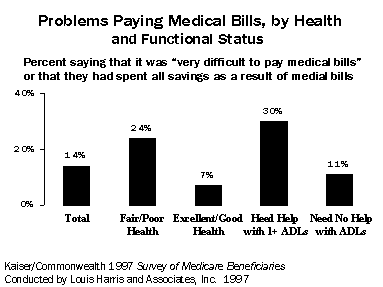
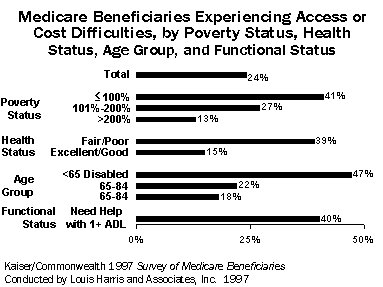
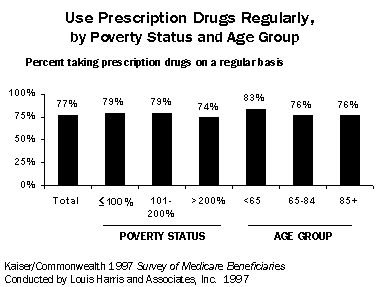
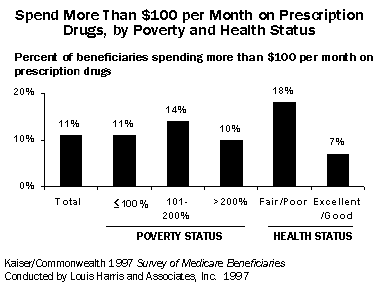
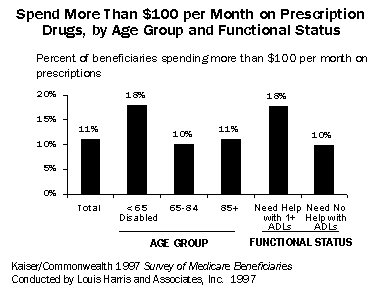
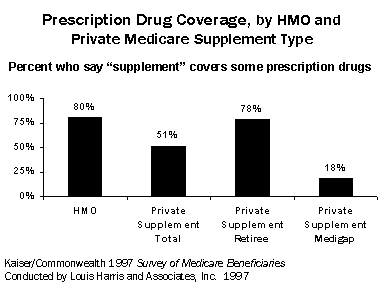
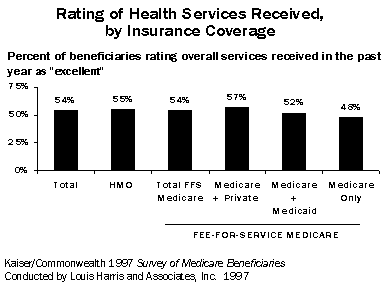
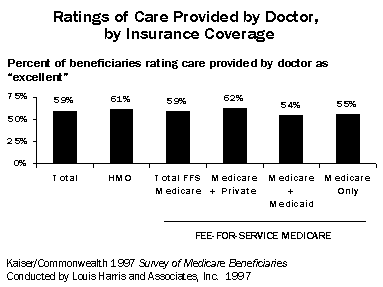
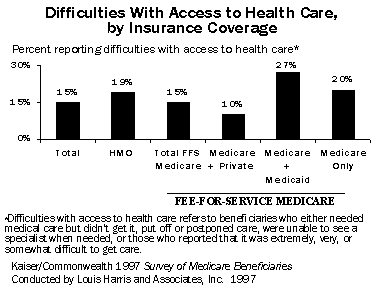
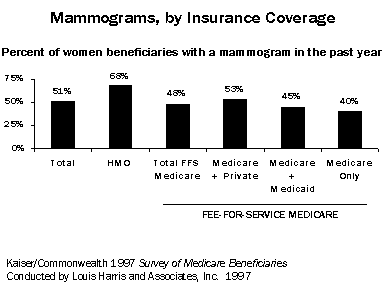
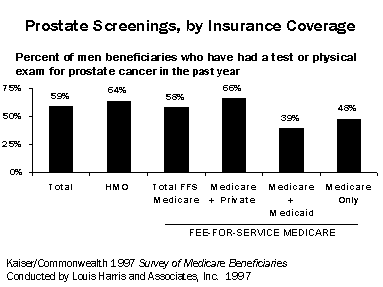
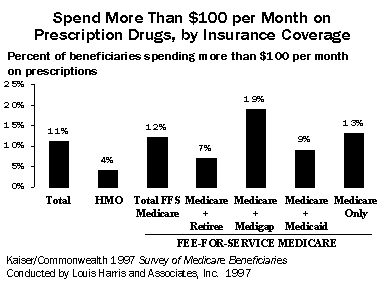
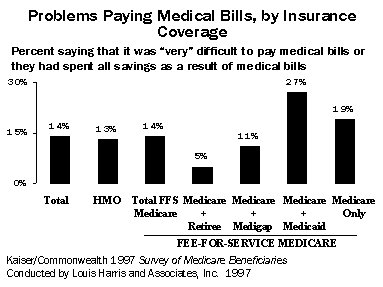
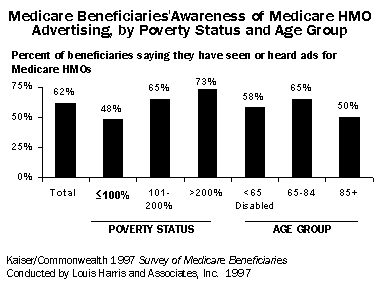
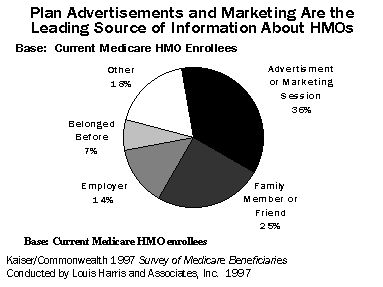
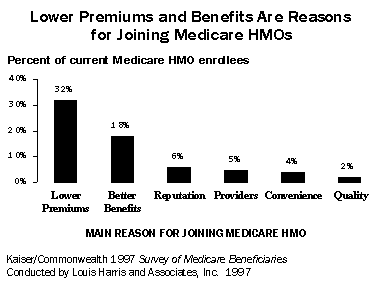
Report Appendix B: Charts Part 1 Appendix B: Charts Part 2Appendix C: Tables Part 1 Appendix C: Tables Part 2Medicare Beneficiaries: A Population at RiskLibrary Index
Medicare Beneficiaries: A Population At Risk – Findings from the Kaiser/Commonwealth 1997 Survey of Medicare Beneficiaries
This report by the Henry J. Kaiser Family Foundation and the Commonwealth Fund, based on the Kaiser/Commonwealth 1997 Survey of Medicare Beneficiaries, highlights the challenges facing Medicare beneficiaries and the importance of addressing the needs of low-income and other high-risk segments of the Medicare population.
A summary of findings from the Foundation’s survey of teens on HIV, and other relevant facts about how young people are being affected by HIV/AIDS.
In 1978, the state of Michigan established a system to call on independent medical experts to help resolve disputes between health plans and patients about the medical necessity and appropriateness of care. Since then, twelve other states and the Medicare program have established similar kinds of external review programs. In the first half of 1998, five more states enacted external review laws (and two states passed laws modifying or expanding existing programs).
The term “external review” means different things to different people. In this paper, “external review” refers to a formal dispute resolution process, established by a state or federal agency to be independent of disputing parties, that has the capacity to evaluate and resolve at least those disputes involving medical issues. State health plan regulators have other responsibilities that are sometimes characterized as external review. For example, virtually all state insurance departments, and many state health departments, accept, investigate and help resolve consumer complaints about their health plans regarding marketing behavior, premiums, and contractual terms of coverage and exclusion of benefits. However, these complaint resolution processes were not included in this study unless they also incorporate a formal process for resolving disputes over medical issues.
Using this definition, this research identified and studied external review programs in thirteen states and in the Medicare program. Medicare’s external review system, established in 1989, is one of the oldest-behind Michigan (1978) and Florida (1985). Unlike state programs, which require consumers to affirmatively request an appeal, Medicare requires that all denials upheld by the health plan’s internal review process must automatically be forwarded for external review. Only in three states and Medicare are external review systems set up to resolve all types of consumer disputes – whether or not they involve clinical issues. The other ten study states have established a separate external review process for disputes involving issues of medical necessity or appropriateness; other disputes not about clinical issues must be pursued through a different process. Based on a review of these programs and interviews of experts involved with them, this paper identifies critical features of external review systems and how they vary. (See Table 1.) State and federal policymakers contemplating creation of new external review requirements may benefit from the lessons learned by the states and Medicare.
Report (.pdf)
An analysis of the external review process, the formal dispute resolution process established by state or federal agencies, independent of disputing parties, that has the capacity to evaluate and resolve at least those disputes involving medical issues. This paper identifies critical features of external review systems in thirteen states and in the Medicare program.